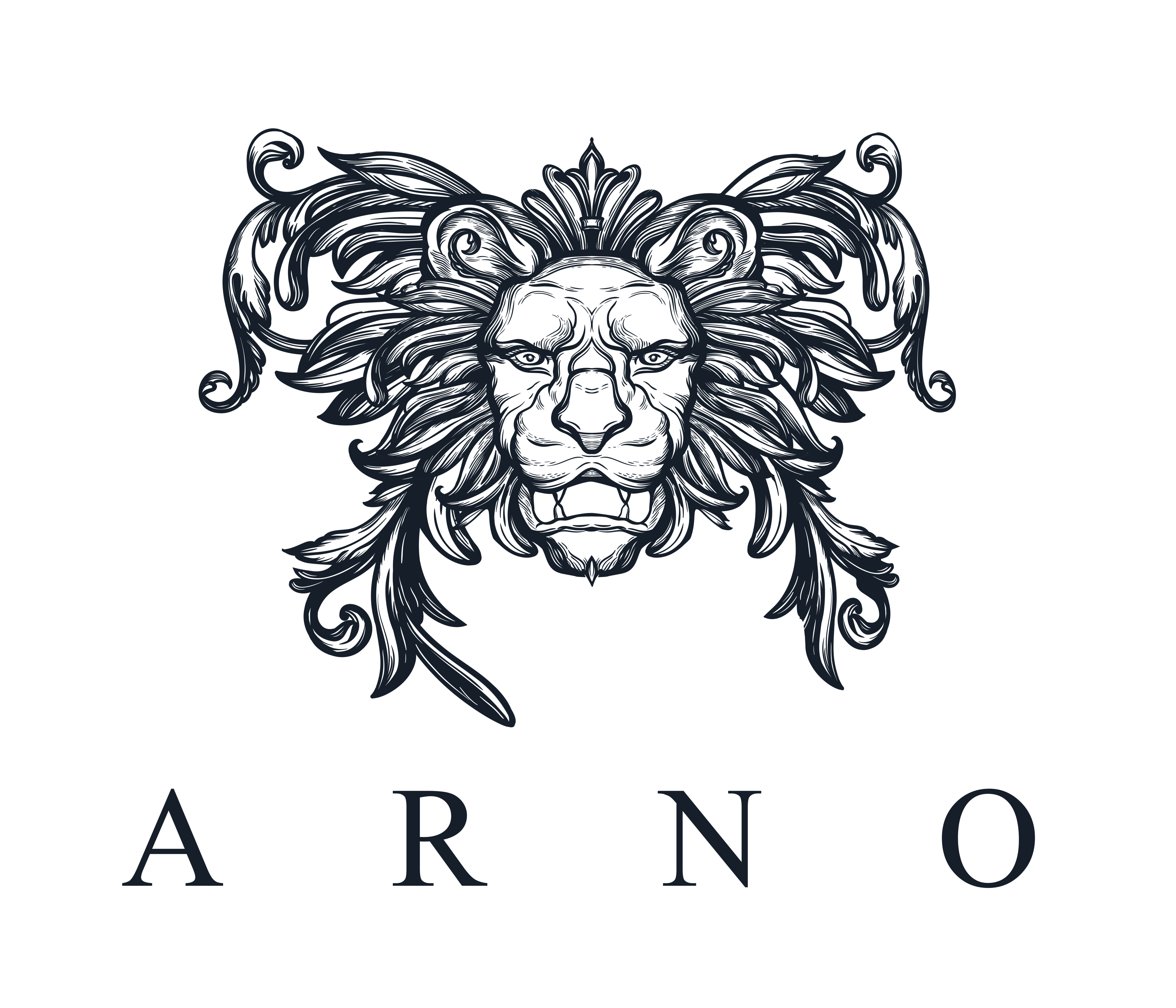Shoe Lab

My first pair of hiker boots using Dark Green "Rude" Culatta from Conceria Cloe. It is a shrunken, tumbled horsehide with the shell cordovan membrane still attached. The shell shrinks at a different rate than the leather so you get this gnarly texture.

Ladies wingtip boot with black shark vamps and purple python tops.

Derby shoes using Maryam Horsebutt TPR. I dont remember the color name, but it is a ruby color with a slight orange tinge. Copper eyelets and Dainite soles.

I don't make cowboy boots often because they take a lot out of me. I had to put this pair away a few times and work on different projects in between. I sure am happy with the finished pair though, and it motivates me to take up another project like this. I used Kangaroo for the tops, including the twisted roses and stems, with goucho kudu uppers. They have a pegged waist and a notched heel.

I had the idea of making a summer shoe a while ago for myself. This is the end result. It is built on a loafer last with a lower heel, and I lowered the facing down to only three eyelets so the foot is a bit more open on it. I used waxed flesh kangaroo for the upper with a very nice calf lining, so these are super soft and pliable, and very light. The single leather sole and dovetail heel made for an easy break-in. The waxed flesh should evolve nicely on this pair.

Another custom Vishivanka boot I made for my sister in law. These are ladies 4.5 E, so very small and very wide, a typical ladies width is B. Burnt Red kudu from CF Stead with a handmade embroidery piece and white/black accents throughout. Something I picked up from bootmaking has been using different color threads, I used two rows here, one red, one white. It is a minor thing but I love the effect!

A pair of custom Vishivanka boots. Loden Suede from CF Stead is such a great and versatile color, with a patch of Ukrainian embroidery to liven it up.

This pair was a challenge. Kudu longwings with hippo facing and heel counter, on a single leather sole.


My first foray into alligator leather. Turned out ridiculously good! The color is a steel gray, I added pink piping, a burgundy suede tongue, and used pink thread throughout.




This is my take on the iconic Galway style boot. Using Maryam Horse Breech vamps and shrunken bison tops from Law Tanning. This pair is made using Norwegian construction with a hand stitched outsole.


These boots have been a long time in the making. I had the idea of creating an embroidery inlay when I was making my Ukrainian cowboy boots. This is a traditional Ukrainian embroidery pattern used in shirts called Vishivanki, cross stitched by an aunt of mine. The leather is a pull-up shell cordovan from Maryam, with a Kudu tongue and a hippo heel counter.

I really nailed the pattern on this one, look at those curves! Horween Pioneer Hatch Grain leather with Olive TPR horsehide from Maryam.

Second go at a moc toe derby, using Revesco Sego from Maryam Tannery.

Black Horsehide TPR from Maryam Tannery in a French WW2 Paratrooper boot style.

Another one off the list of different styles to make. Engineer boots in Revesco Sego from Maryam Tannery, two different tones.
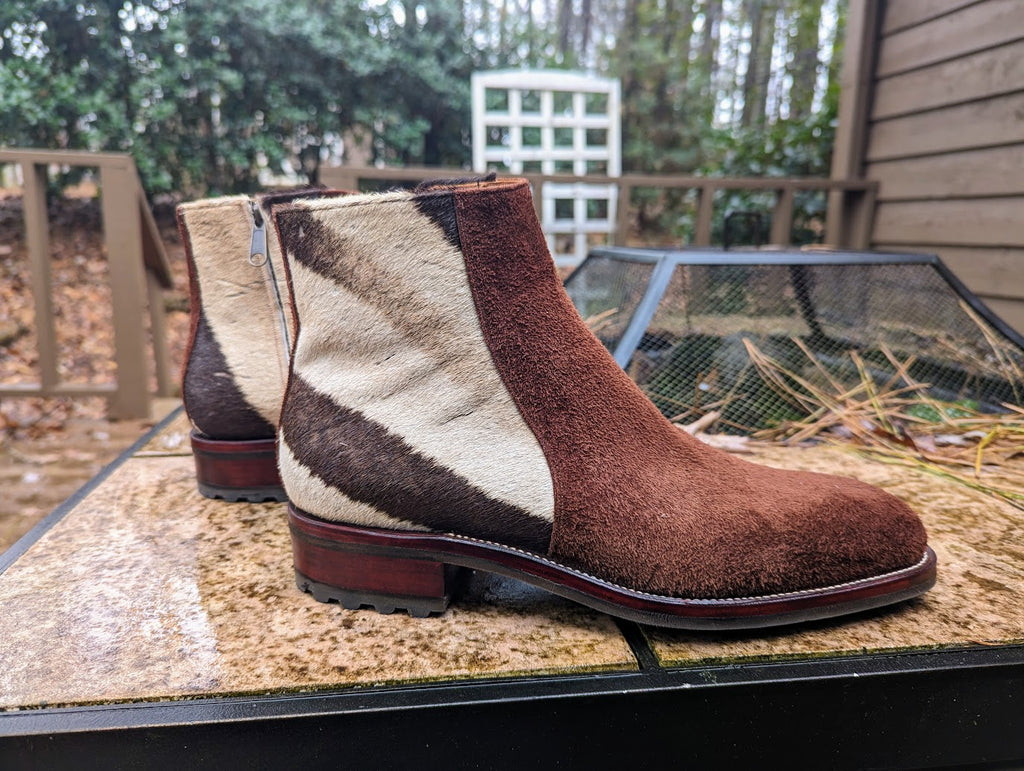
When I initially made my first pair of zebra hair on hide slippers, my friend Chuck at Tulsa Shoe Rebuilders gave me a scrap of real zebra hair on hide he had laying around. I have no idea where it originated, but it looks like a self tanned piece so probably some safari hunt who knows when. The stripes were a bit too big to incorporate properly into a shoe so the hide sat around for a while until inspiration hit. I paired this with some roughout CF Stead "Unicorn" leather (no idea why they call it that, its elk). I like the final result, it's kind of loud, but only if you see it from the side. From the front or top down it just looks like a normal pair of boots.
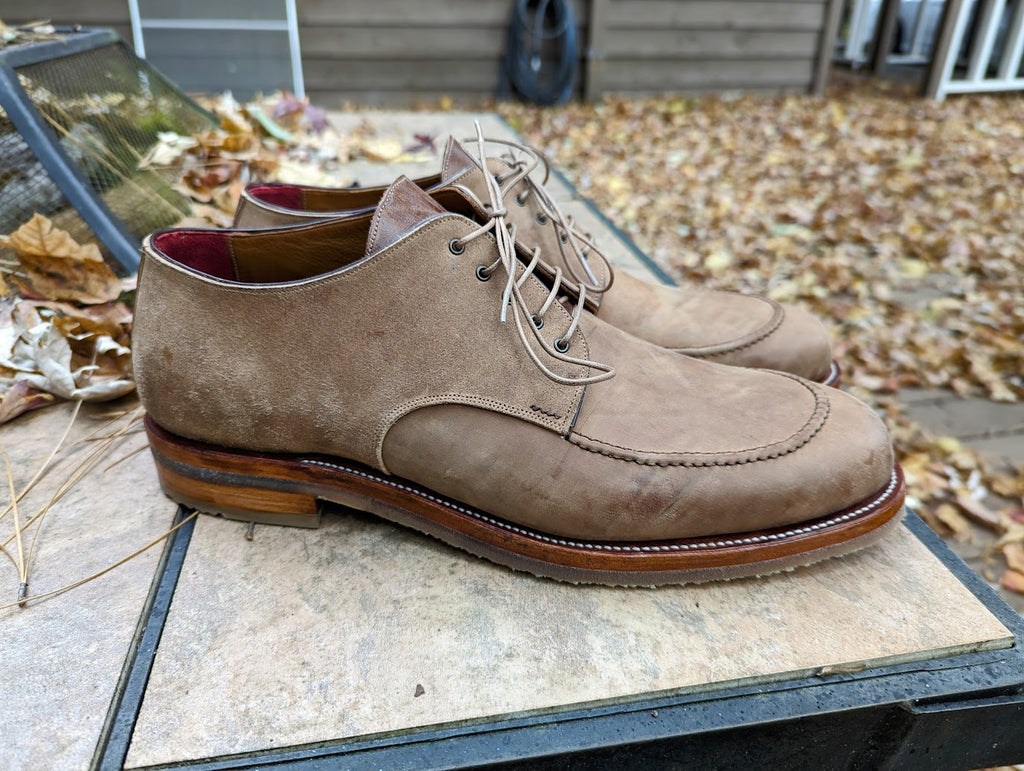
A pair of moc toe derbies using Revesco Sego leather from Maryam tannery in Italy. It is a reverse horsehide treated with alum, which flattens the grain and gives it a smooth feel. You can see portions of the shell cordovan in the vamps (the discoloration).

What I love about cowboy boots is their ability to tell a story. There is a lot more real estate to work with in the tops! In 2022 after the invasion of Ukraine I was deployed to Germany to translate for the USAF. We worked with the Ukrainian Air Force, so these boots are built to commemorate that cooperation, the top portion is the Ukrainian Air Force logo, while the bottom is the USAF logo. Lesson learned, inlays are a LOT of work! The tops are made out of kangaroo, and the vamps are waxy kudu from C.F. Stead.

Another ladies boot! Japanese calf uppers with orange python tops in a Galway style boot. I had some shell cordovan scraps that I used for the heels to give it a little more color. Some ginger boots for my brother's red head fiancee.
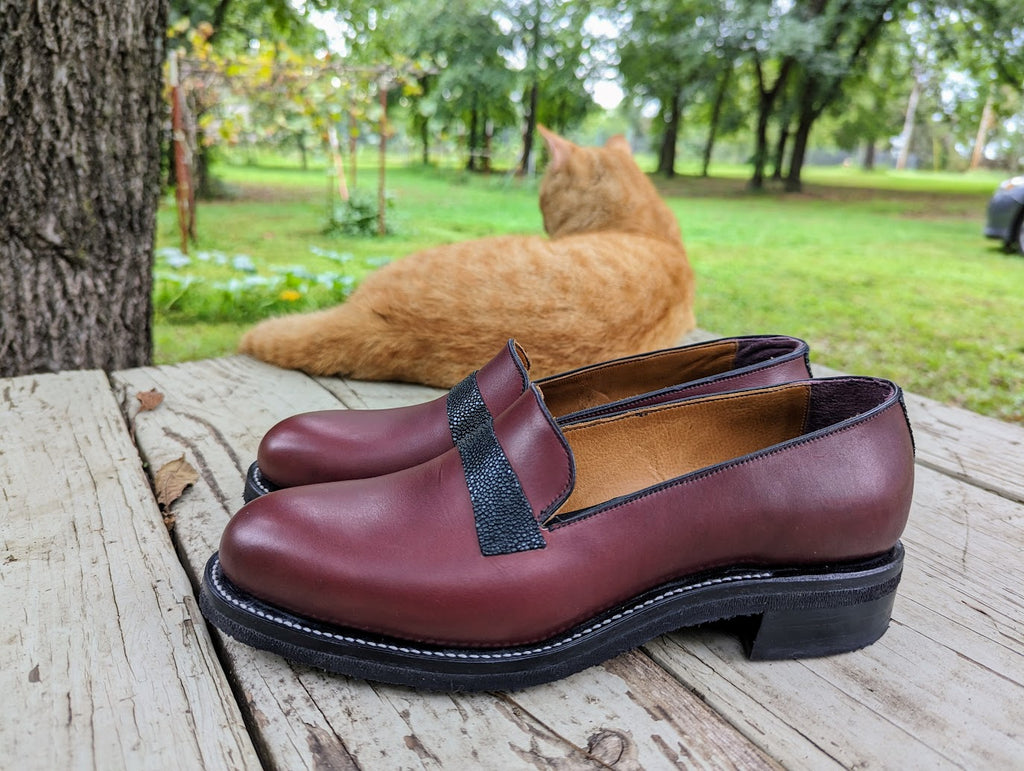
A pair of loafers for my friend Maria. Using Annonay calf for the uppers with some stingray accents, I decided to go for a chunky heel and sole to give them some clout.

This is a fun pair. A custom Bliskavka boot with help from Tulsa Shoe Rebuilders. The customer wanted a boot that was unmistakably custom, so here we are. Python and black horsehide. I made the pattern, upper, and lasted this pair. Tulsa Shoe Rebuilders did the rest.
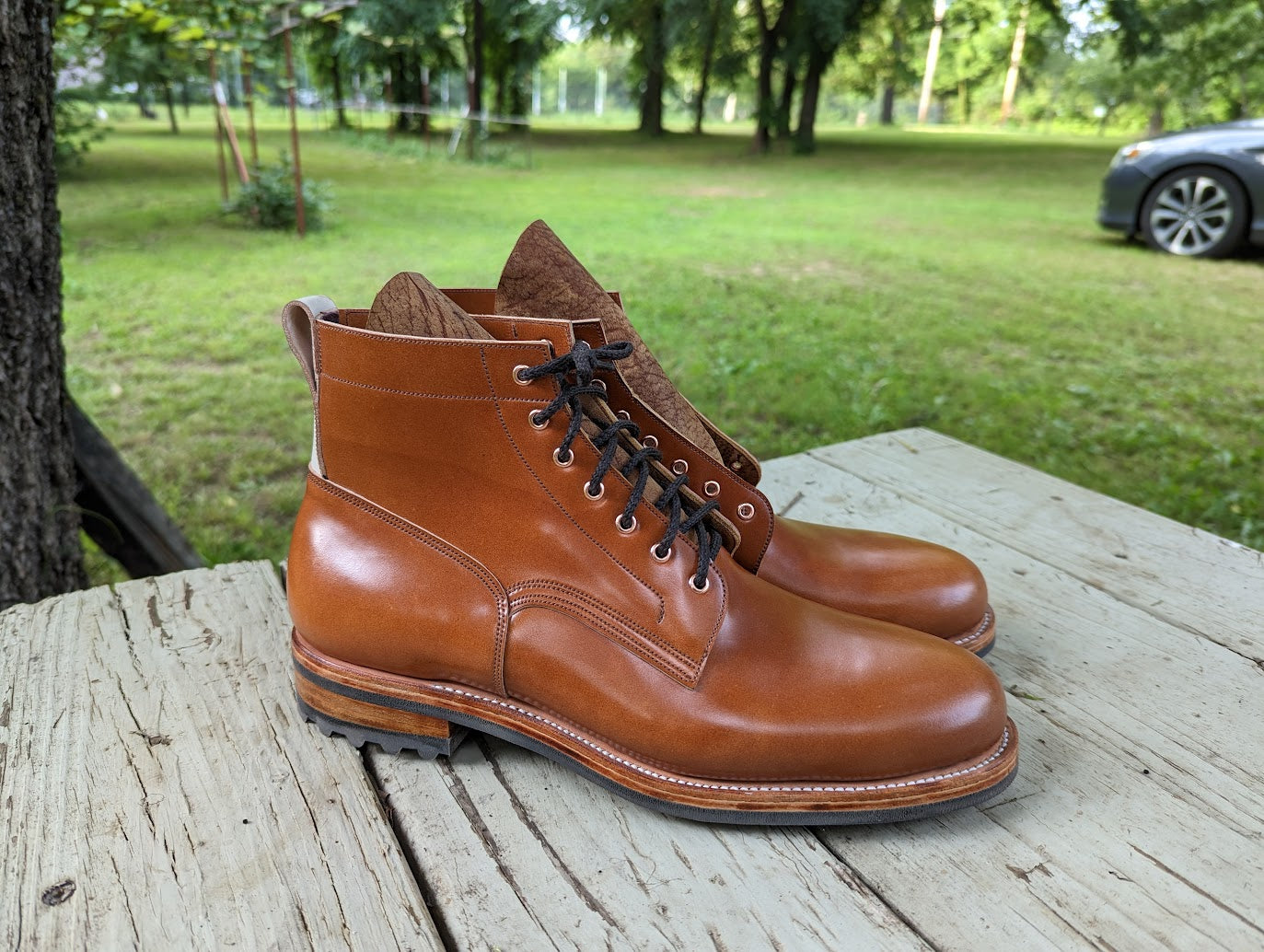
I don't like using the word masterpiece, but I am going to here. I have been hesitant about working with shell cordovan after my initial foray into it. I've made a lot of boots since that first time and learned a few tricks so I felt like I can try it again. This is my take on Viberg's Bobcat pattern. Imitation is the sincerest form of flattery, and since they don't make that style anymore I think its fair game. I used some shell cordovan that I picked up on my trip to Japan in 2019 for the uppers, Shinki "ghost" shell cordovan for the pull tab, and some CF Stead kudu for the tongue. Copper eyelets for some extra pop, and a lugged Lactae Hevea natural crepe sole for a rugged look. It all comes together for a truly one of a kind boot. I wish I had the foresight to buy more of that shell cordovan, I only had two pieces and I used it all up to make this pair. The photo doesn't do the color justice, and it positively glows in the sunlight. Excited to see how this pair evolves with wear!

I tried to crimp this J&FJ Baker Russian Reindeer replica leather, but it doesn't have much stretch so the end result wasn't great. I got some help making a pattern that doesn't require crimping this time, and this is the end result. A beautiful look, and on a lugged Lactae Hevea natural crepe sole for ultimate comfort.

Take two on the slipper. Turns out, you want slippers a half size smaller to accommodate for a sock-less look. I tweaked the pattern a bit, and added a heel this time.


This is one of my rare commissions. I was asked to recreate the famous Corthay two eyelet derby, but with my own flair. This is the end result, I added some red piping extended all the way down for something to catch the eye. The pattern was challenging to create and later to last. Compared to a normal derby, the facing is placed much farther back into the waist, which caused strange wrinkling whenever I was lasting it. I ended up having to wet last this pair, but it was worth the effort and I am thrilled with the results!


Shark take two. I really enjoyed making the first pair and was able to get a few more skins recently. The grain is not as pronounced on this pair, and the color is a bit lighter, so I decided to contrast it with black detailing. Black shark tongue and heel counter, with black kidskin piping and the welt dyed black to show off the contrasting white stitching.

A fun project for a friend of mine. Making the pattern was a challenge because this was my first attempt at an asymmetrical design, I think the end result looks amazing though. I chose two similar leathers, both are replicas of the famous Russian reindeer leather that was recovered from a shipwreck. The darker shade is Horween's version, and the more chestnut color is from J&FJ Baker.

I wish I could find another shark hide this perfect. I’ve looked, but haven’t been able to match a center ridge this pronounced. It also has little white speckles all over when you look closely. The only pattern suited for such a unique and interesting hide is a whole cut. In this case, I added a brown shark backstrap so its not a “true” wholecut. Someday!

I saw this hair on hide at a leather shop in Dallas and knew I had to get it, even though I didn’t know what I would do with it yet. A few months later, here we are. The strappy jodhpur pattern from before, but on a ladies last.

Testing out a new last here! Oliva Vachetta from Maryam Tannery in Tuscany is a wonderful thing. Thick but soft and flexible, it is a fairly simple veg tan without all the waxes and oils, so it should patina beautifully. The tan heel counter and tongue match up with the copper eyelets and natural edges.

I think I’ve already gushed over C.F. Stead’s kudu here a few times. Here is a version of my side zips with black kudu. Amazing how you can dress up a pair of shoes by just changing minor details, like a leather sole and matching edges.

I got this beautiful calf skin from J&FJ Baker a tannery in the UK that specializes in making the absolute best leather for all of the internal components of a shoe. They have two leather options that are good for shoemaking, the Russian Reindeer replica and this waxed flesh calf. When I got it, I loved the skin side of the hide so much that I decided to use it instead of the waxed flesh side, but to incorporate that as well I included a heel counter, tongue, and the little side pieces. The upper should patina beautifully, and the wax will scuff off the side pieces to reveal the fuzzy roughout.

The task was to create an austerity wingtip boot, all the details were at my discretion. It turned out to be a bit of a wingtip/Galway mix. Japanese calf vamps, with a darker heel counter piece from Tannerie d’Annonay, and shrunken bison vamps with copper eyelets. The bison is incredibly soft, so it just hugs your ankles. I’m obsessed with the lines on this pair, and the calf simply glows in the sun.

First go at a Jodhpur boot, Maryam Salvia (Sage) reverse horsehide, with Jamaica Kudu straps from CF Stead. The flesh side of the hide is heavily waxed, as they get worn the nap will start coming visible.

Take two on the buckle boots, this time with the buckles on the correct side! J&FJ Baker Russian Calf uppers with brass hardware. One of the interesting characteristics of this leather is how the oils and waxes eventually "bloom" to the surface, this is a good example of how that looks like after a little bit of time. You can brush it to remove the white.

My brother approached me for a pair of casual boots in some sort of brown color. Here is the result. Petrolio horse breech from Maryam Tannery, with a Toscanello horsehide tongue, on a lug sole with copper eyelets. Turned out even better than I imagined, green is a lot more versatile than you’d expect!

Going back to my roots with a pair of derbies using Zonta museum calf, in which the tannery adds a surface dye with a mottled effect to it. Light colored piping, a blind waist that’s secured with wooden pegs completed the refined look.

Aaaand a second one. Same pattern as above, but a different last. This pair is for myself, using three different horsehides from Maryam Tannery, four if you count the gusseted tongue. TPR Horsebutt on the counters, vachetta (soft vegetable tanned horsehide without any finishing on it) for the quarters, and a slightly waxier tannage for the vamps. The original color of the vamps was a softer, almost pink color so I added a bright red surface dye to make it pop. This is another pair for me, if I’m making a pair, might as well make it slightly wild right?

Something a bit more casual. This is my take on the classic “Service Boot” style that Viberg has made popular in recent years. A little bit more refined, in my opinion. The vamps and heel counter is TPR horsebutt from Maryam, it has a resin coating that gives it a nice glossy shine. I chose a matching red kudu from CF Stead for the quarters for the interesting variation in the grain, and because of it’s soft hand which comfortably hugs the ankles. Black horsehide gusseted tongue with matching eyelets wrap up the look.

The first pair of the new year, in spectacular fashion. Jamaica Kudu from CF Stead is the centerpiece here, but I’ve managed to cram some color in regardless. Medium brown edges, green piping, red kudu tongue, some purple on the heel lining, with beige laces really making it pop.

Something a bit more refined. Black calf from the Italian Tannery, Zonta. I added some purple piping to the topline to give it a little color, and kept the contrast on the sole stitch.

My first foray into ladies shoes, a Chelsea boot using Fango Horsebutt from Maryam. I really like how the maroon elastic complements the pale cream of the upper.

Maybe my favorite pair right now, the Bitter Chocolate Kudu from Charles F Stead in the UK shows off its characteristic scars and grain. I took some inspiration from the colorful stitching on cowboy boot tops on the green stitching here. That’s further tied in with green piping and dark green edge coloring. Not immediately obvious but a treat on the second glance.

This pair has been a long time in the making. My second pair of cowboy boots ever, made for my sister. Uppers are plum calf from Tannerie d’Annonay in France, with Italian calf uppers. I went with a lavender chainstitched Norvegese construction, mostly because they were already over the top and I’ve never seen that construction method on cowboy boots before.

This pair has been a lesson in paying attention to your work. After making the initial pattern and uppers, I realized I didn’t take proper measurements and made the top circumference of the boots too small. Queue the remake, where for some reason I got into my head that the buckles should be on the inside of the shoe. They’re finally done, but I already have another pair of uppers in the works, this time with the buckles on the outside! This is special leather from J&FJ Baker in the UK, it is a reproduction of the famous Russian reindeer leather recovered from a 200 year old shipwreck. It is as close to the original tanning techniques as possible, using cow hide however.

I’m on a Maryam horsebutt binge here. This one is glazed Toscanello color and much thicker. I was trying to make a very formal shoe pattern and shape as casual as I could. A heavy duty leather, some contrast with the stitching and edge dressing, and I think this was a success. Not visible in this picture, but the topline and tongue are a dark burgundy color for a bit of flair.

This is what the kudu sidezips from before were a test run for. Horsebutt from Maryam which is a really special leather, tough but supple, and has an interesting grain. I had to play around with dyes to get this color, but I think the end result is beautiful. The leather sole and dark edge dressing makes this pair seem a lot dressier than the prior iteration.

A special project for a friend of mine, the ultimate patina boot! Using Revesco Sego leather from Maryam, its a reverse horsebutt with the shell cordovan membrane still intact. Natural edges, natural thread for the Norvegese stitch, copper eyelets. This pair should age beautifully.

Its nice to get back to my roots with a classic dress shoe. Black Calf from Zonta (Italian Tannery), with red accents and a bright red sole.

My first attempt at a side zip boot. Turned out great, this is Waxy Retan Kudu from CF Stead in the UK. A beautiful leather that’s full of character, it’s a nubuck finish (where the skin is lightly sanded), that is then heavily waxed. These are wild animals that are culled for food, and the leather is a byproduct so it exhibits the scars that the animal accumulated in life, which adds an interesting visual effect. I really love the shape of these, and feel like a rockstar every time I wear them.

A special project for an “online shoe friend.” This is a vintage deer hide that’s been laying around for something like 50 years. It was a challenge to assemble the uppers, because of how soft it is, my sewing machine kept slipping and sliding. Turned out beautifully though. This is also the first time I’ve attempted a bellows tongue.
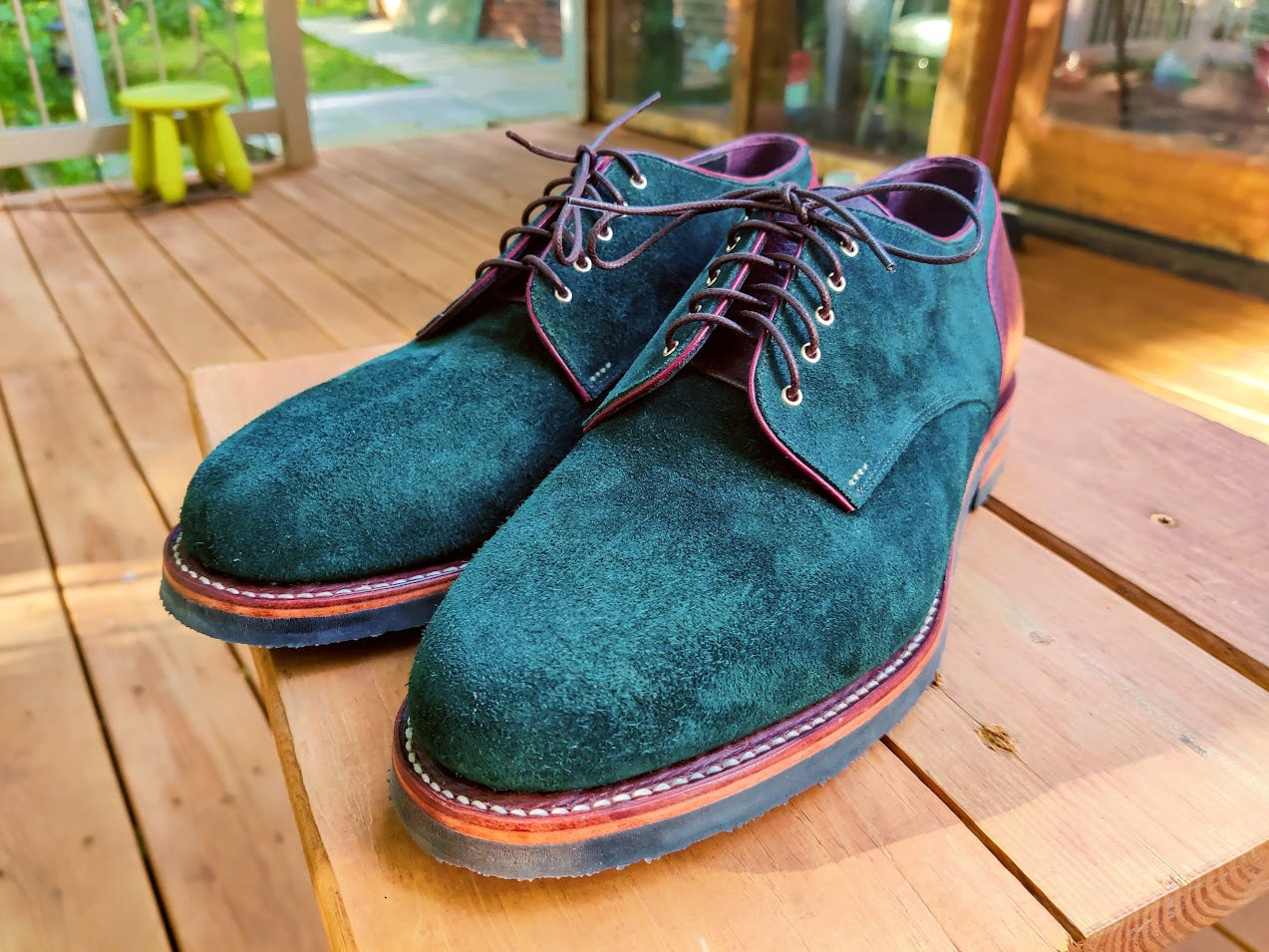
I saw this leather in a product shot for a completely different color suede. I spent a good two weeks hunting down a source for it before finally getting a hold of someone at CF Stead through their social media and getting the last two hides they had in stock. Worth it. Beautiful pair of summer derbies in Green Night suede and a red Kudu heel from CF Stead. Copper eyelets and red piping tie it all together.
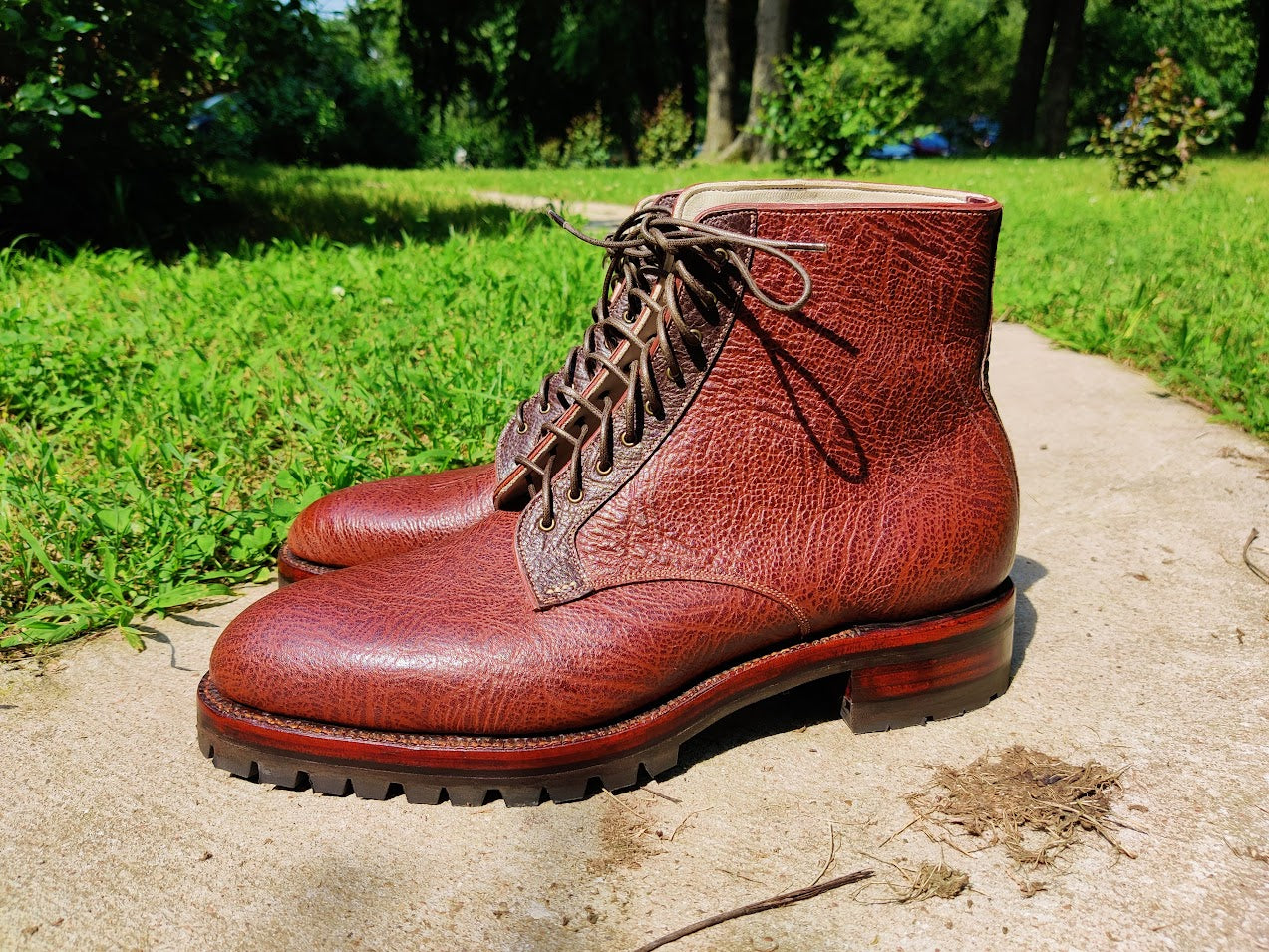
Field boot style, on my dress shoe last in Jamaica Kudu from CF Stead. I love this leather, it is printed (this isn’t the natural grain), but its very unique and dense with a soft hand. My goal here was to make an elegant boot, with as heavy duty of a sole that I could. I think I succeeded.

Conceria la Bretagna Milled Ghost bullhide. Another cool leather covered in a layer of white wax that will eventually wear out to show the black underneath. Notice the little bit of purple peeking out on the heel lining, I have incorporated that into all my boots after this pair.

Bordeaux calf from Tannerie d’Annonay. The copper eyelets are one of my favorite parts of this shoe.

My first pair of taller derby boots. This is the iconic Galway style using Horween Pioneer leather for the vamps, and loden suede for the shaft.

And this is my foray into bootmaking. I met a bootmaker here in Tulsa, Dan Hickman. He was kind enough to coach me on pattern making, and on the key difference in construction techniques between shoes and cowboy boots.

I got a few hides of Shinki "ghost" shell cordovan. This is a lesson in knowing what materials you're working with, and that not all is lost when you think you messed up. The idea with this leather is that the white wax will wear off and show the black shell cordovan underneath. This made lasting the leather very difficult, because I couldn't soak it and it has very little stretch anyway. I made two pairs like this and when I was pulling them off the last, the leather tore at the base of the facing. After all of that effort it was a bit heartbreaking. My friend Chuck quickly reassured me that it's not over until its over! We came up with an elegant solution, adding little lizard skin patches to cover the tear and reinforce the area.

A matching pair I made in black "ghost" shell cordovan, also with the tear, here the patch ended up giving it a bit of a tuxedo vibe.

A pair of chukka boots for my cousin using C.F. Stead Loden suede with Lactae Hevea natural latex soles.

My first attempt at a pair of boots using black shell cordovan from Maryam tannery in Italy. A lot of lessons learned, namely, shell cordovan is incredibly difficult to work with!

This is my first official commission from someone other than a relative or a friend. It is still one of my favorite pairs. Using Zonta Burgundy Museum Calf which has a really nice mottled effect for the uppers, I also added black calf under all of the broguing and black piping. The construction is a combination Norvegese with a fiddleback waist.
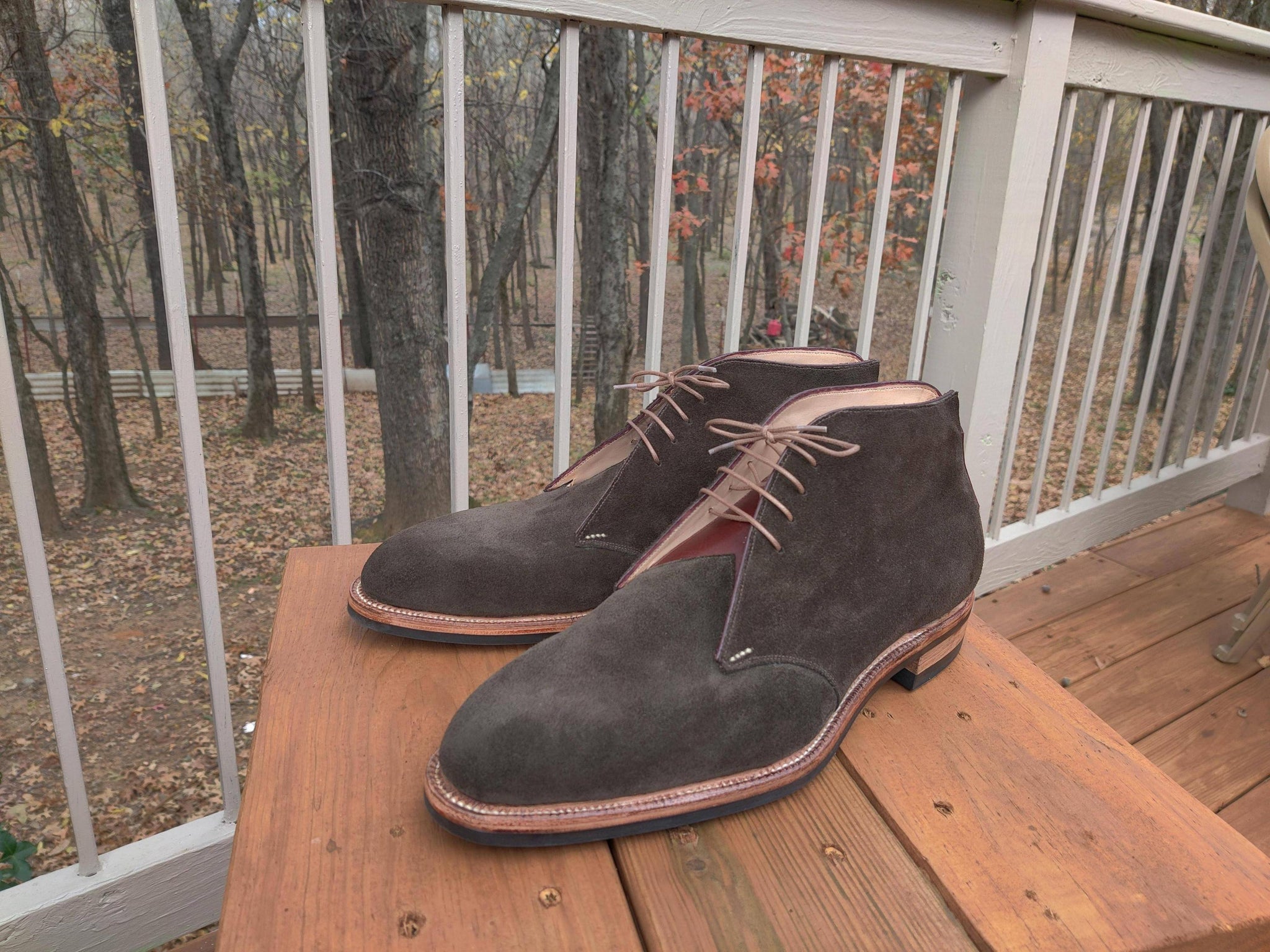
When I learned shoemaking, I was only able to make it for the three month course instead of the usual six months. That means I never actually learned the pattern making technique for boots, but a friend of mine sent me some reference material so it was mostly trial by error. This is officially the first boot I made, chukka seemed like a nice compromise since at the end of the day it is just a slightly extended shoe. CF Stead Loden Suede with a Dainite sole.

Life is too short for boring shoes. That is why everyone needs a pair of oxfords made from Plum French calf from Tannerie d'Annonay.

I had some shark skin scraps from my wholecut pair, so I decided to incorporate them into these oxfords. The vibrant Japanese calf with the heavy grain of the shark really makes for an excellent combination.

A pair of derbies using a red kudu leather from C.F. Stead. I saw that the color was called "Sign" and decided to buy it on a whim, turned out to be a great choice.

A second take on oxfords with the French calf/suede combo. You can see some definite improvements in my ability on this pair.

A pair of loafers using a Japanese calf for my friend Daniel. The facing is a little bit Star Wars inspired.

As you can see, I am on a bit of a Norvegese binge with these pairs. The first wholecut shoe I made using a beautiful brown shark hide.
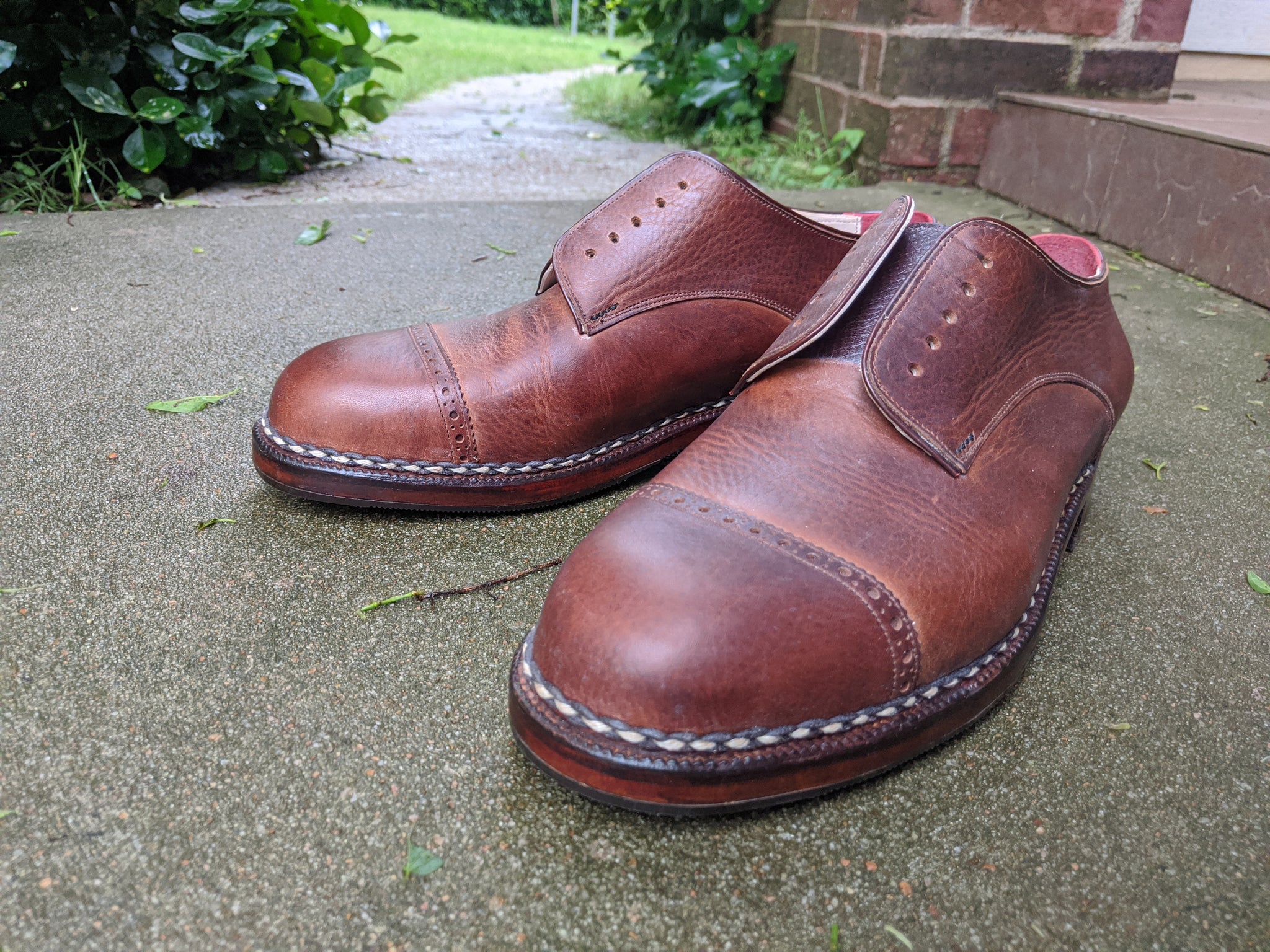
A pair for my brother in law, I was experimenting with making some derbies as beefy as I could with some oil tan leather I had laying around.

A nice pair of derbies for my friend Ethan. I made these using Norvegese construction, but without the braided stitching. The upper is Horween Pioneer calf.

A pair for my brother using Tannerie d'Annonay french calf and suede.

My graduation pair from the Stefano Bemer shoemaking school in Florence, Italy. The upper is using Ilcea Museum Calf, with a combination Norvegese/Goodyear welt construction to accommodate for the fiddleback waist.

The shoes that started this entire journey. I came in to my friend Chuck's shop because I had a really light semester in college and leatherwork seemed kind of cool to me. I asked if I can help him around the shop a bit, maybe learn a thing or two. He had me do some stitching practice first, but it seems I caught him at the perfect time because he also had just made some patterns for a pair of chukka boots. I ended up making this pair using his patterns and I was hooked.
